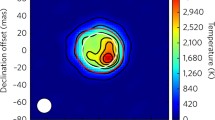Abstract
The structure of shocks propagating through partially ionized hydrogen gas with characteristics typical of the atmospheres of RR Lyr, W Vir, and RV Tau type variables is analyzed in terms of a self-consistent solution of the equations of gas dynamics, atomic kinetics, and radiation transfer. The solutions were obtained for shock waves with velocities 20 km/s≤U 1≤90 km/s and unperturbed hydrogen gas with temperatures 3000 K≤T 1≤9000 K and density ρ1=10−10 g/cm3. The fraction of the energy of the gas-dynamic flux converted into radiation increases with the shock amplitude, and the ratio of the radiation flux emitted by the shock to the gas kinetic energy flux is 0.4≲ℜ≲0.8 for the velocities U 1 considered. This ratio also increases slightly with the ambient gas temperature T 1 due to an increase in hydrogen ionization in the radiative precursor. The flux emitted by the leading edge of the shock opposite to the gas flow is several percent higher than the flux emitted in the opposite direction by the trailing edge of the shock. Radiation is mostly concentrated in the Balmer continuum, and the region of efficient Lyman radiation transfer includes gas layers located near the viscous jump (δX=±104 cm). The final gas-compression ratio in units of the limiting compression corresponding to an isothermal approximation is virtually independent of the shock amplitude, and increases with the unperturbed gas temperature from r≈0.5 at T 1=3000 K to r≈0.9 at T 1=9000 K.
Similar content being viewed by others
References
H. A. Abt, Astrophys. J., Suppl. Ser. 1, 63 (1954).
G. Wallerstein, Astrophys. J. 127, 583 (1958).
G. Wallerstein, Astrophys. J. 130, 560 (1959).
R. Scott and S. R. Baird, Publ. Astron. Soc. Pac. 94, 850 (1982).
S. R. Baird, Publ. Astron. Soc. Pac. 96, 72 (1984).
L. A. Willson, Astrophys. J. 205, 172 (1976).
M. W. Fox, P. R. Wood, and M. A. Dopita, Astrophys. J. 286, 337 (1984).
D. Gillet, Astron. Astrophys. 192, 206 (1988).
L. A. Willson and S. J. Hill, Astrophys. J. 228, 854 (1979).
Yu. A. Fadeyev, Lect. Notes Phys. 305, 174 (1988).
Ya. B. Zel'dovich and Yu. P. Raizer, Physics of Shock Waves and High-Temperature Hydrodynamic Phenomena (Fizmatgiz, Moscow, 1963; Academic, New York, 1966, 1967), Vols. 1, 2.
I. A. Klimishin, Shock Waves in Stellar Envelopes [in Russian] (Nauka, Moscow, 1984).
D. Mihalas and B. W. Mihalas, Foundations of Radiation Hydrodynamics (Oxford Univ. Press, New York, 1984).
A. L. Velikovich and M. A. Liberman, Physics of Shock Waves in Gases and Plasmas [in Russian] (Nauka, Moscow, 1987).
Yu. A. Fadeyev and D. Gillet, Astron. Astrophys. 333, 687 (1998).
Yu. A. Fadeyev and D. Gillet, Astron. Astrophys. 354, 349 (2000).
P. Feautrier, C. R. Acad. Sci. Paris 258, 3189 (1964).
G. B. Rybicki and D. G. Hummer, Astron. Astrophys. 245, 171 (1991).
R. E. Marshak, Phys. Fluids 1, 24 (1958).
Author information
Authors and Affiliations
Additional information
__________
Translated from Astronomicheski\(\overset{\lower0.5em\hbox{$\smash{\scriptscriptstyle\smile}$}}{l}\) Zhurnal, Vol. 78, No. 5, 2001, pp. 421–431.
Original Russian Text Copyright © 2001 by Fadeev.
Rights and permissions
About this article
Cite this article
Fadeev, Y.A. The structure of shocks in the atmospheres of pulsating stars. Astron. Rep. 45, 361–370 (2001). https://doi.org/10.1134/1.1369799
Received:
Issue Date:
DOI: https://doi.org/10.1134/1.1369799



